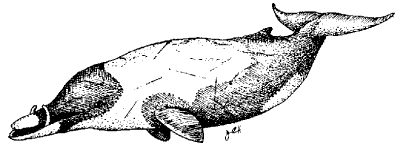 |
Science Frontiers ONLINE No. 113: Sep-Oct 1997 |
|
|
Acoustical Pipes In Beaked Whales?
Because they are relatively rare, the comings and goings of beaked whales remain largely unrecorded. These mammals are effectively toothless for predatory purposes. In fact, some marine biologists speculate that they secure their slippery prey by suddenly vacuuming them up by actuating a pumplike tongue. (AR#2)
But how do the beaked whales find their prey in the first place? With their sonar, of course. But these superbly streamlined animals lack the huge external ears of the sonar-using bats. How do they detect the weak echoes bouncing off fleeing fish?
P. Zioupos and J. Currey, at the University of York, have drawn attention to the rostrum bone that forms the beaklike upper jaw of Blaineville's beaked whale. At 2.7 grams/cubic centimeter, this bone is 50% denser than the average mammalian bone.
"The bone also turned out to have unique chemical properties. It contains 35 per cent calcium by weight -- 13 per cent more than the highest value known previously. Using microscopes, the team showed that the bone is riddled with tiny tunnels. containing highly concentrated minerals."
The channelled nature of this bone make it very brittle, making it unlikely that it is used as a ram in mating bouts. Zioupos and Currey propose that this uniquely structured bone is really an acoustical pipe for the beaked whales' sonar signals.
(Barnett, Adrian; "Do Whales Talk through Brittle Beaks?" New Scientist, p. 20, May 10, 1997.)
Comment. Acoustical pipes were also invented by close relatives of the beaked whales, the dolphins. With the dolphins, it is the lower jaw that has been converted into a "sound pipe" for receiving sonar echoes. Dugongs, too, possess squamosal bones filled with oil that are probably also connected with sound detection. Evolution has been highly innovative -- three times, in different ways -- in designing acoustical pipes in marine mammals! This is very impressive for a method that begins with a random process. More details in BMO7-X1 in Mammals II.
 | This strap-toothed whale is one of the beaker whales. The teeth of this male prevent it from opening its mouth more than a couple of inches. Blaineville's beaked whale has two large, leaf-like teeth projecting upwards and forwards. These grotesque teeth are often covered with barnacles! |